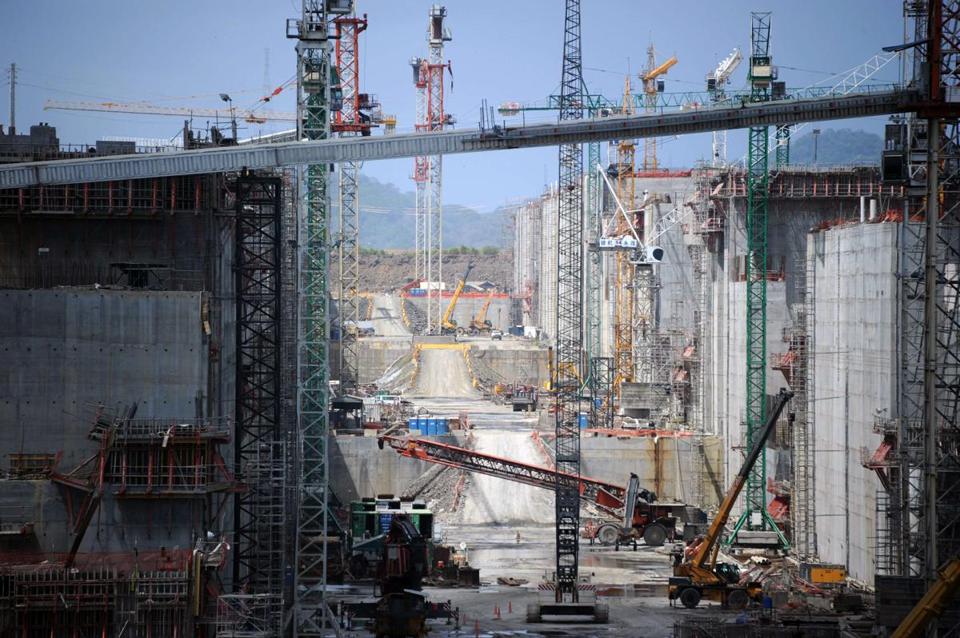With some 16 months to go before we finish the first canal expansion, could another set of locks to handle even bigger ships be in its future? The question raises another question, how will we find the water capacity to fill all of these new locks?
The idea first surfaced last year during a Latin American ports conference in Bogota when Rodolfo Sabonge, a Panama Canal Authority marketing and development executive, said the authority was studying whether demand would warrant a fourth set of locks.
But it seemed to gain credibility last week when a Chinese engineering delegation visiting Panama expressed interest in being part of a new locks project.
The Panama Canal’s third set of locks, which are expected to open to regular ship traffic in early 2016, will be able to accommodate so-called post-Panamax vessels that are as long as three football fields and can carry about 2.5 times the number of containers of the ships that currently transit the canal. But even bigger ships are being built.
Most U.S. tankers that carry liquefied natural gas to Asia fall into the post-Panamax Plus category — five times too big for the current canal. The fleet of these super-sized ships is expected to grow.
So it’s perhaps no surprise the Chinese are interested in another canal expansion.
A Chinese delegation led by Mo Wenhe, chairman of Beijing-based China Harbour Engineering Co., and Wei Hua Wang from the Chinese-Panamanian Office of Business Development, met last week with Jorge Quijano, the canal administrator.
“We are exploring our participation in all canal projects, especially in the design, construction and financing of a fourth set of locks,” Mo said.
CHEC, which plans to set up its regional headquarters in Panama, has 10,000 employees and works in 80 countries.
In recent years, China has invested in strategic infrastructure projects throughout Latin America.
Meanwhile, Chinese telecom tycoon Wang Jing is eyeing another route for a Central American canal — through Nicaragua. The canal he envisions would be three times as long as the Panama Canal, would be able to handle super tankers and has a $60 billion price.
There has been the perception that even though the United States turned over control of the canal to Panama in 1999, China wants its own Atlantic-Pacific water route because it regards the Panama Canal as still in Washington’s sphere.
Nicaragua has granted a 50-year renewable concession to build a canal through the Central American country to Wang’s Hong Kong-based HKND Group, but there are a lot of skeptics from environmentalists to those who question whether the technology and financing are there for such a massive venture.
“I don’t think the Nicaragua canal is a real starter,” said Michael L. Conniff, a San Jose State University history professor who wrote the book “Panama and the United States: The Forced Alliance.”
“The Panamanians have staked an awful lot on the expansion and that will have a pretty important impact on world trade in the future,” Conniff said.
Canal officials say the current expansion is about 78 percent complete.
The irony of China’s interest in the Panama Canal is that Panama is one of the few countries in the Americas that don’t have diplomatic relations with mainland China. It has ties with Taiwan and Taiwanese President Ma Ying-jeou visited Panama on July 1 for the inauguration of President Juan Carlos Varela.
According to a cable released by WikiLeaks that was sent by the former U.S. ambassador here, Panama had explored switching its allegiance to Beijing but was rebuffed by China in a 2010 meeting because China didn’t want to jeopardize its improving relationship with Taiwan.
While Varela is clearly interested in China, it looks like the status quo of diplomatic relations with Taiwan and an economic relationship with China will continue for the time being.
“Without any doubt, China is the future but the diplomatic truce must be respected,” Varela said in June after meeting with the editorial board of the daily La Estrella de Panama.
